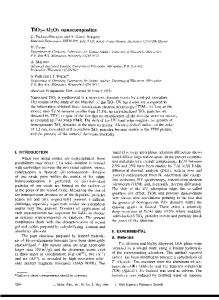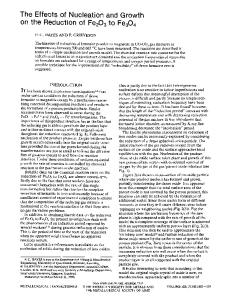Studies of the photocatalytic and electrochemical performance of the Fe 2 O 3 /TiO 2 heteronanostructure
- PDF / 3,039,269 Bytes
- 16 Pages / 595.276 x 790.866 pts Page_size
- 43 Downloads / 459 Views
ORIGINAL PAPER
Studies of the photocatalytic and electrochemical performance of the Fe2O3/TiO2 heteronanostructure Abdelhak Othmani2 · Salah Kouass1 · Thamer Khalfi3 · Sabrine Bourchada4 · Fathi Touati3 · Hassouna Dhaouadi3 Received: 25 March 2020 / Accepted: 29 June 2020 © Iranian Chemical Society 2020
Abstract The α-Fe2O3/TiO2 nanostructure material, synthesized on FTO (fluorine-doped tin oxide) substrate using the hydrothermal method at 180 °C for 5 h, exhibits an enhanced performance in the photocatalytic degradation of an organic dye. The optical band gap was found to decrease compared to the T iO2 one. The photocatalytic performances of the as-prepared heterojunction were evaluated with the degradation of methylene blue (MB) in an aqueous medium. The results revealed that the photocatalytic activity of the Fe2O3/TiO2/FTO was much higher than that of the pure T iO2. In addition, the photocurrent of the Fe2O3/TiO2/FTO heterojunction was remarkably higher than that of the bare T iO2 electrode. The obtained results indicate that the heterojunction formed between Fe2O3 and T iO2significantly improved the separation efficiency of the photo-generated electron–hole pairs. The electrochemical properties of the as-synthesized nanocomposite materials (α-Fe2O3/TiO2) were also evaluated with cyclic voltammetry for 1000 cycles. This nanocomposite exhibited an enhanced specific discharge capacity compared to the Fe2O3 nanomaterial. The as-produced material proved to have an impressive performance as a high-capacity anode for Na+-ion batteries. Keywords Nanocomposite · Heterojunction · Photocatalytic properties · Electrochemical properties
Introduction Green energy sources have been extensively investigated in an attempt to replace fossil fuels, which have inherent pollution problems, and given the limited availability of resources [1]. In particular, the photocatalytic conversion of solar energy into chemical energy or into hydrocarbon fuels has been of great significance in environmental conservation and energy utilization [2, 3]. Over the last few decades, much attention has been paid to the production * Salah Kouass [email protected] 1
Laboratoire des Matériaux Utiles, INRAP Sidi-Thabet, 2020 Tunis, Tunisia
2
Faculté des Sciences de Bizerte, LR01 ES15, Laboratoire de Physique des Matériaux: Structure et Propriétés, Université de Carthage, Faculté des Sciences de Bizerte, 7021 Zarzouna, Bizerte, Tunisia
3
Laboratoire Matériaux, Traitement et Analyses, INRAP, Technopole Sidi‑Thabet, Ariana Tunis, Tunisia
4
Laboratoire de Chimie des Matériaux, Faculté des Sciences de Bizerte, 7021 Zarzouna, Bizerte, Tunisia
of various photocatalysts such as: TiO2 [4], Au/ZnO [5], C3N3S3 [6] and M oS2 [7]. Titanium dioxide ( TiO2) is one of the most commonly used photocatalysts given its efficiency in pollutant degradation in waste water, and also because of its inexpensiveness, strong oxidizing power, hard-soluble and long-term photostability [4]. However, its wide band gap requires excitation wit
Data Loading...











